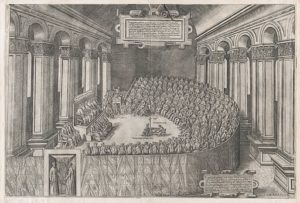Eyewitnessed Historia and the Renaissance Media Revolution: Visual Histories of the Council of Trent
by Evonne Levy
The essay begins:
I look at a good painting . . . with as much pleasure as I take in reading of a good story [historia]. Both are the work of painters: one paints with words, the other tells the story with his brush. —Leon Battista Alberti
 What happened when the most important genre of Renaissance painting, the historia (a “visual history”), built its images on scenes of eyewitnessed current events disseminated in the new medium of print? Is it a coincidence that a new claim to the eyewitnessing of current events in paint occurred in the fifteenth century, around the time that print made such palpably new histories available to a wide audience? While this essay will not undertake to prove that mechanical reproducibility put pressure on the historia to disseminate events as they appeared and as they happened, it will attempt to show the transformative encounter of these two things. A series of representations of a signal historical event enables us to see the convergence of the eyewitnessed image and print in action, and I propose to treat the meeting of the Council of Trent (1545–63) as my example, in part out of perversity. This event, which was in reality a visually uninteresting series of meetings (rows of people talking) spanning decades, was represented in a way that was both more textured and detailed than previous such scenes. And the long arc of time over which the council met was dealt with visually by representing what appears to be a single moment, a radical (and arbitrary) condensation in pictures—in a manner equivalent to the boiling down of a long war, with its many skirmishes, by representing a single moment in a single battle that in itself may have been of no particular significance. We will see, though, that a visual history that looks right to the eye in a given instant is still an image that has been put to work by specific agents. It was usually not sufficient merely to show a historical event; the artist had to make sense of it, to interpret it, to declare a position. The historia remained intact, and yet the eyewitnessed image, by virtue of its visual media, also had a stimulating effect as evidence-based history. Continue reading …
What happened when the most important genre of Renaissance painting, the historia (a “visual history”), built its images on scenes of eyewitnessed current events disseminated in the new medium of print? Is it a coincidence that a new claim to the eyewitnessing of current events in paint occurred in the fifteenth century, around the time that print made such palpably new histories available to a wide audience? While this essay will not undertake to prove that mechanical reproducibility put pressure on the historia to disseminate events as they appeared and as they happened, it will attempt to show the transformative encounter of these two things. A series of representations of a signal historical event enables us to see the convergence of the eyewitnessed image and print in action, and I propose to treat the meeting of the Council of Trent (1545–63) as my example, in part out of perversity. This event, which was in reality a visually uninteresting series of meetings (rows of people talking) spanning decades, was represented in a way that was both more textured and detailed than previous such scenes. And the long arc of time over which the council met was dealt with visually by representing what appears to be a single moment, a radical (and arbitrary) condensation in pictures—in a manner equivalent to the boiling down of a long war, with its many skirmishes, by representing a single moment in a single battle that in itself may have been of no particular significance. We will see, though, that a visual history that looks right to the eye in a given instant is still an image that has been put to work by specific agents. It was usually not sufficient merely to show a historical event; the artist had to make sense of it, to interpret it, to declare a position. The historia remained intact, and yet the eyewitnessed image, by virtue of its visual media, also had a stimulating effect as evidence-based history. Continue reading …
In this essay Evonne Levy examines the collision of Renaissance narrative or historia in the visual arts and the eyewitnessed event and the pressure put on that convergence by the dissemination of the latter in the new print media. The example discussed here is the Council of Trent, a storyless but signal event that conformed with difficulty to an ideal “historia,” and one that was often depicted after eyewitnessed scenes of the event had already been disseminated in engravings. The veracity of the scene captured in a print created new chains of media: prints led to paintings, and to more prints, and images led to written history, rather than vice versa.
 EVONNE LEVY is Professor of Early Modern Art History at the University of Toronto. She works on the art, architecture, and historiography of the baroque in Europe and Latin America.
EVONNE LEVY is Professor of Early Modern Art History at the University of Toronto. She works on the art, architecture, and historiography of the baroque in Europe and Latin America.
